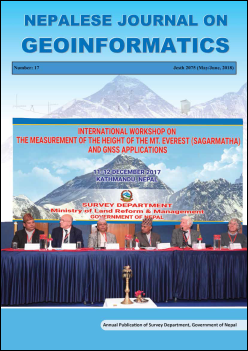Spatial Distribution and Temporal Change of Extreme Precipitation Events on the Koshi Basin of Nepal
DOI:
https://doi.org/10.3126/njg.v17i1.23007Keywords:
Koshi Basin, Extreme precipitation events, Climate change, Inverse distance weighting, Kriging interpolationAbstract
Climate change, particularly at South Asia region is having a huge impact on precipitation patterns, its intensity and extremeness. Mountainous area is much sensitive to these extreme events, hence having adverse effect on environment as well as people in term of fluctuation in water supply as well as frequent extreme weather events such as flood, landslide etc. So, prediction of extreme precipitation is imperative for proper management. The objective of this study was to assess the spatial distribution and temporal change of extreme precipitation events on Koshi basin of Nepal during 1980-2010. Five indicators (R1day, R5 day, R > 25.4 mm, SDII and CDD) were chosen for 41 meteorological stations to test the extreme events. Inverse distance weighting and kriging interpolation technique was used to interpolate the spatial patterns. Result showed that most extreme precipitation events increased up to mountain regions from low river valley; and then it decreased subsequently up to Himalayan regions (south to north direction). However, there is high value of indices for lowland Terai valley also. Most of the indices have hotspot with higher value at north western and southern part of the study area. For temporal change, most of the extreme precipitation indices showed increasing trend within 30 years’ period. The spatial distribution of temporal change in indices suggests that there is increasing trend in lowland area and decreasing trend in mountainous and Himalayan area. So, adaptive measure should be adopted through proper land use planning, especially at those hotspot areas and their tributaries; to reduce adverse effect of extreme precipitation events.




